Webinars have become an essential tool for businesses of all sizes, educators, and content creators – they’re a go-to strategy for sharing valuable information, connecting with audiences, and generating leads. But if you’re looking to host a webinar, one big question looms: should you go live or pre-recorded?
Each format offers its own set of advantages, and knowing when to use each type can make a major difference in how engaging and effective your event will be.
In this guide, we’ll explore the key differences between live and pre-recorded webinars, their pros and cons, and provide the best practices and tips to help you improve both formats effectively.
What is the Difference Between Pre-recorded and Live?
Live webinars are hosted in real-time, maximizing audience engagement and interaction. In contrast, pre-recorded webinars are edited for a polished presentation, making them great for recurring sessions or on-demand viewing. While live webinars allow immediate interaction, pre-recorded webinars provide flexibility and consistency.
Before diving into the pros and cons of each webinar type, let's understand what makes live and pre-recorded webinars different.
Let’s take a look at the basic characteristics of each format.
What is a Live Webinar?
A live webinar is an interactive, real-time online event where the host connects directly with the audience. It’s a chance for the host to answer questions, get real-time feedback, and create an engaging, responsive experience that feels more personal.
The “live” element encourages immediate interaction through features like Q&A sessions, polls, and chat functions, which can create a sense of community and trust.
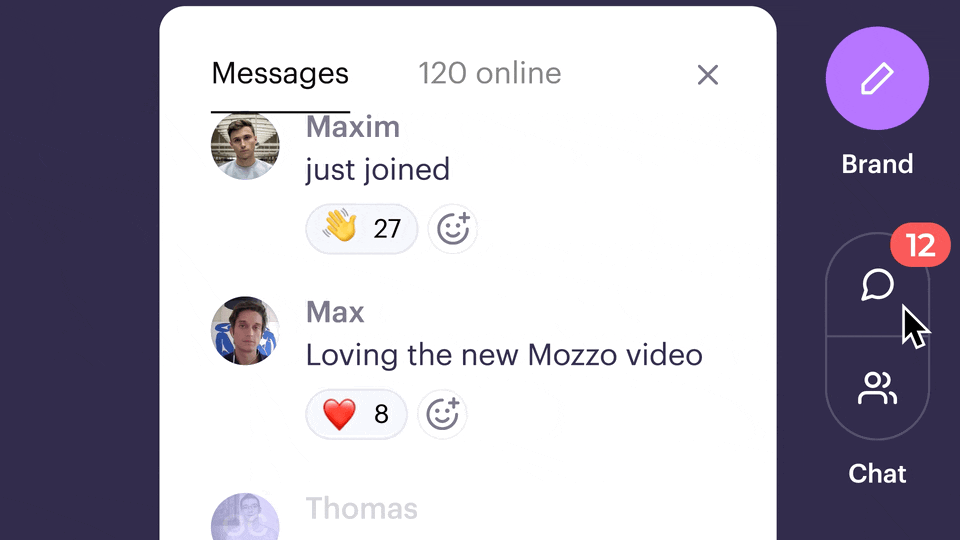
Live webinars are ideal when:
- Building personal connections: Direct interactions humanize the brand and build relationships.
- Responding to questions on the spot: Real-time Q&A allows the host to address specific questions or concerns from the audience.
- Creating urgency and exclusivity: The one-time nature of a live event often pushes people to attend.
- Capturing Authentic Moments: Live webinars can capture spontaneous, genuine interactions that resonate with viewers. These moments can be repurposed into short videos, blog posts, or social media snippets.
However, live webinars come with their own challenges. They require careful planning and scheduling, and technical glitches—like audio issues, lag, or dropped connections—can disrupt the experience.
What is a Pre-recorded Webinar?
A pre-recorded webinar, also called an on-demand webinar, is a recorded session that can be accessed by viewers at any time. Unlike live webinars, these can be improved through editing, offering more control over the final product’s polish and clarity.
Even with pre-recorded webinars, you can still engage your audience effectively. For example, you can incorporate polls throughout the session to gather viewer opinions or insights, encouraging interaction even after the event has aired.
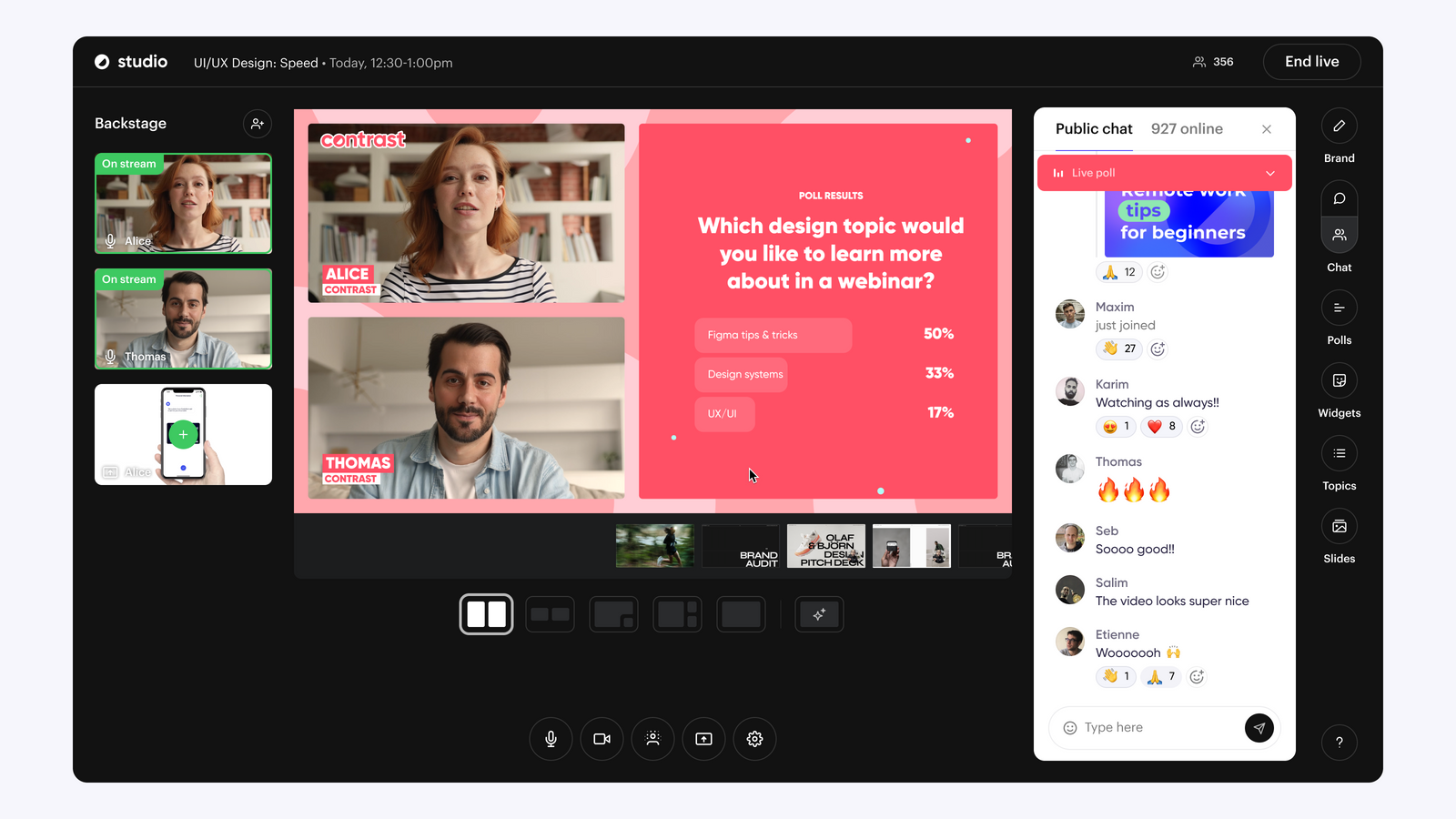
They allow both the host and the audience greater flexibility, as attendees can watch whenever it’s convenient.
Pre-recorded webinars are a great choice for:
- Training and demos: Product demo webinars deliver a consistent experience for all viewers.
- Evergreen content: They’re effective for lead generation over time. Evergreen webinars allow hosts to collect contact details in exchange for access.
- Repurposing content: You can easily turn recorded webinars into short videos, blog posts, or social media content.
While pre-recorded webinars are convenient, they lack the spontaneity of live events. Audiences who enjoy engagement and real-time interaction may find them less exciting.

Run Live or Pre-Recorded Webinars to Engage your Audience
Start for free with up to 30 registrants. No credit card needed.
Start for freePros and Cons of Live Webinars
Live webinars can be highly engaging, but they also bring some limitations.
Here’s a breakdown of the main benefits and challenges of hosting a webinar live.
Pros
- Real-Time Interaction: Live webinars allow for instant communication with the audience via Q&A, polls, and chat. This is especially valuable for clarifying complex topics, gathering feedback, or answering questions as they arise.
- Sense of Urgency: Since live webinars are typically one-time events, they create a sense of “now or never,” which can drive higher attendance and engagement.
- Authenticity and Trust: The unscripted nature of live webinars can make them feel more authentic and transparent, helping to build trust with audiences.
Cons
- Time Zone Challenges: Scheduling a live event that works for audiences in different regions can be tough, limiting the number of attendees. Make sure to pick the best time and day for your event to maximize attendance rates.
- Technical Glitches: Live webinars are vulnerable to technical issues—anything from a slow connection to audio lag—which can impact the experience.
- Limited Post-Event Engagement: While recordings of live webinars can be shared afterward, most attendees engage best during the live event itself. Replays often lack the same excitement.
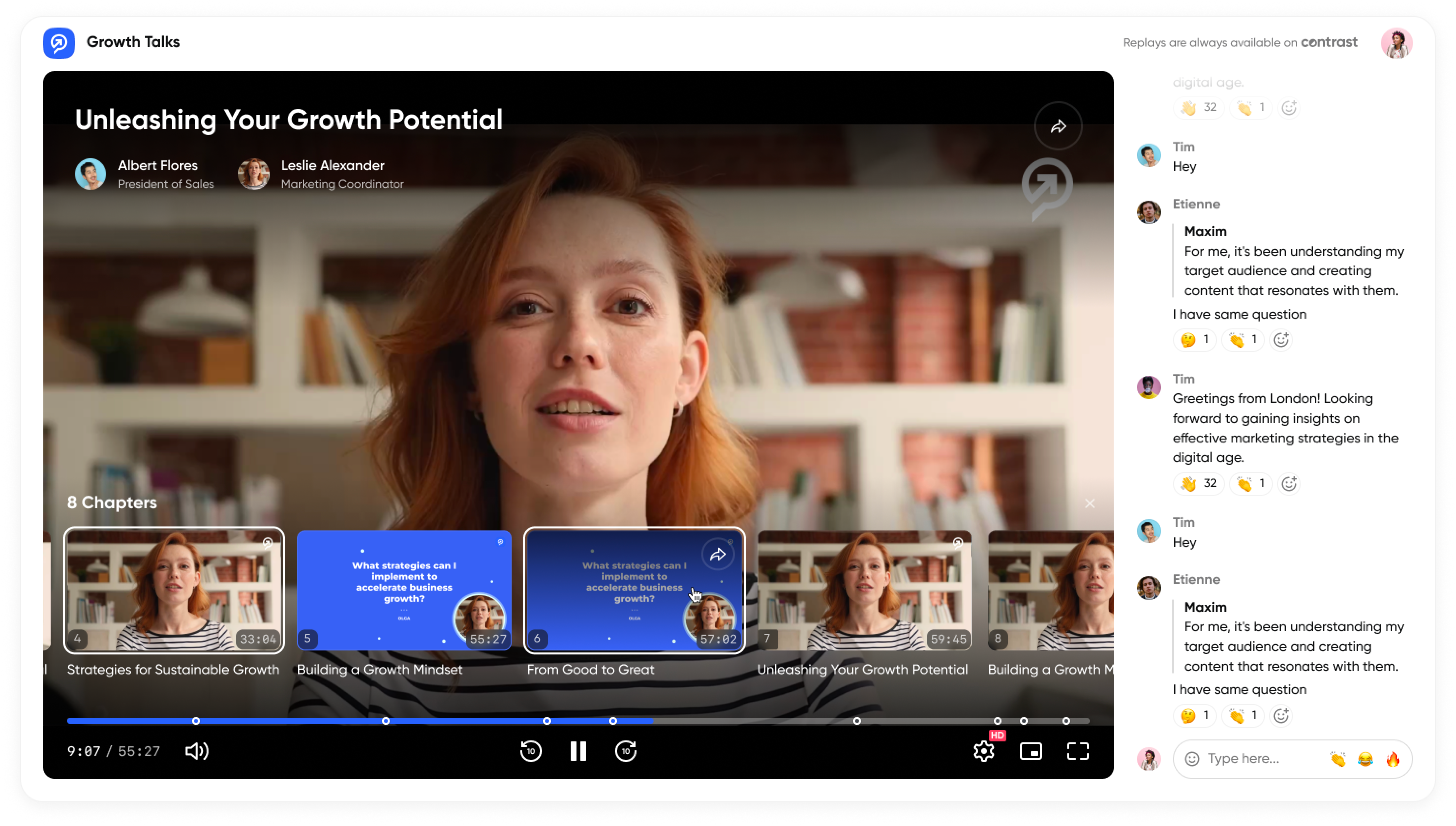
Pros and Cons of Pre-recorded Webinars
Pre-recorded webinars bring their own strengths and limitations.
Here’s a look at their main benefits and challenges.
Pros
- On-Demand Flexibility: Since they can be accessed at any time, pre-recorded webinars offer flexibility for global audiences who may not be available for a live session.
- Content Control: With pre-recorded webinars, hosts can record the webinar first, and edit the content to ensure clarity, cut out mistakes, and add visuals or transitions for a polished final product.
- Evergreen Value: Pre-recorded webinars can serve as lasting content, driving views and leads without the need for ongoing effort from the host.
Cons
- Reduced Engagement: Without a live component, pre-recorded webinars miss out on the elements that make a webinar interactive and can make it feel more engaging.
- High Content Standards: Since pre-recorded webinars can’t adapt in real time, the content needs to be clear and thorough from the start, as there’s no way to adjust based on audience questions.
- Less Personal Connection: For some audiences, pre-recorded webinars lack the genuine, conversational feel that live events provide, which can impact engagement.
Choosing the Right Webinar Type
When selecting a webinar format, consider these common scenarios to determine whether a live or pre-recorded approach is better suited to your needs.
When Pre-recorded Webinars Work Best
Pre-recorded webinars are often the top choice when flexibility, consistency, and long-term usability are priorities.
They’re ideal for:
- Reaching a Broader Audience: The on-demand nature lets people watch whenever convenient, which can expand your reach globally.
- Lead Generation: By requiring registration to view, pre-recorded webinars are a great way to boost your webinar lead generation to can passively more of them over time.
- Product Demos and Tutorials: Pre-recorded webinars work well for instructional content, offering a consistent experience for every viewer and allowing for more polished presentations.
- Training and Development: These webinars ensure that all trainees or new hires receive the same information (trough virtual training for example), making them a solid choice for employee onboarding.
- Repurposing Content: You can repurpose recorded webinars into shorter videos, shared on social media, or turned into blog posts, giving them greater versatility and reach.
- Customer Onboarding: Pre-recorded webinars provide a structured, on-demand resource for new users to learn product features, ensuring consistent knowledge transfer and a smooth onboarding experience.
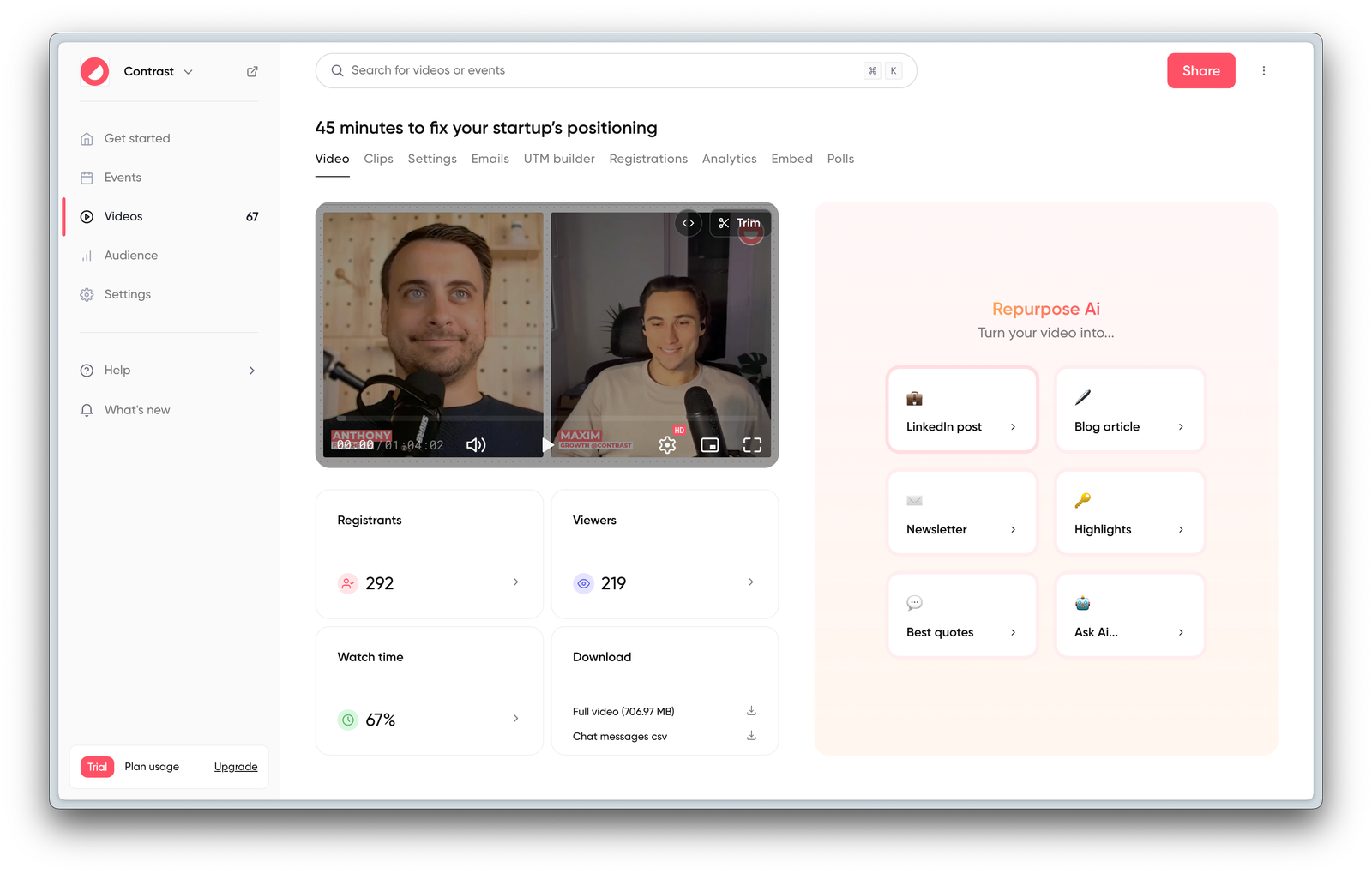
When Live Webinars Work Best
Live webinars are the better option when engagement and real-time interaction are essential.
Consider using live webinars for:
- Creating Real-Time Connection: If you want to interact directly with viewers, gather feedback, or respond to specific questions, live webinars are ideal.
- Hosting Exclusive Events: Live webinars work well for limited-time announcements, launches, and other events where exclusivity can boost interest.
- Engaging Audiences Who Prefer Real-Time Content: Some audiences, especially those who value connection with the speaker, will appreciate the authenticity of a live event.
- Generating Buzz: Inviting exciting guest speakers can create buzz around your live event, drawing more attendees and increasing interest. Plus, including elements like prizes, giveaways, or exclusive content can further entice participation and make the experience memorable.
Common Mistakes to Avoid
When hosting webinars, it’s easy to miss some details that can really impact how effective your webinar is.
Here are some common pitfalls to watch out for:
Common Mistakes for Live Webinars:
- Neglecting Technical Checks: Not testing your webinar equipment and internet connection before going live can lead to glitches that disrupt the event. Always run a rehearsal to catch any issues.
- Ignoring Audience Engagement: If you don’t interact with your viewers, they may lose interest. Incorporate polls, Q&A sessions, and chat interactions to make it more engaging.
- Not Promoting Enough: Just because it’s live doesn’t mean people will show up. Promote your webinar across multiple channels well in advance to maximize attendance.
- Overloading with Information: Trying to cover too much can overwhelm your audience. Focus on key points and leave room for questions to keep things clear.
- Poor Time Management: Going off your webinar script or running over time can frustrate attendees. Stick to your agenda and be mindful of the schedule to keep your audience engaged.
Common Mistakes for Pre-recorded Webinars:
- Skipping the Editing Process: Sending out a raw recording without editing can lead to a incoherent viewing experience. Take the time to polish the final product for clarity and professionalism.
- Lack of Engagement Elements: Pre-recorded webinars can feel a bit static if they don’t include interactive elements. Consider adding polls or prompts to get viewers thinking during the session.
- Not Including a Clear Call to Action: Failing to guide your audience on what to do next can lead to missed opportunities. Always wrap up with a strong call to action, whether it’s signing up for a newsletter or checking out a product.
- Ignoring SEO Best Practices: If you’re hosting pre-recorded webinars on your website, make sure to optimize them for search engines to boost visibility. Use relevant keywords in titles, descriptions, and tags.
- Forgetting Follow-Up: Just because the webinar is pre-recorded doesn’t mean you should ignore your audience afterward. Send follow-up emails with links to the recording, additional resources, or a feedback survey to keep the conversation going.
Avoiding these common mistakes can help you create a more engaging and successful webinar, no matter which format you go with.
Should a Webinar be Live or Pre-recorded?
It really depends on the goal of your webinar. Live webinars will be better at generating authentic engagement from your audience. Pre-recorded webinars will allow for better prodution quality and lower effort.
When to Choose Live Webinars
If your goal is to create real-time engagement, build a sense of community, and create a vibrant atmosphere, a live webinar is definitely the way to go. Live sessions allow you to interact directly with your audience, answer questions on the spot, and respond to feedback as it comes in.
There’s something exciting about the energy of a live event that can really resonate with viewers.
When to Choose Pre-recorded Webinars
If you’re aiming for a polished, well-structured presentation, pre-recorded webinars can be a game changer. They give you the chance to edit and perfect your content before it goes live, ensuring everything flows smoothly.
This format is especially useful if you have complex information to share or if you want to make sure you hit all your key points. Bonus: you get all the webinar analytics without the lift.
In the end, the choice between live and pre-recorded webinars comes down to your style and your audience’s preferences. Some people thrive on the immediacy of a live event, while others appreciate the convenience and clarity of pre-recorded content.
Think about what will resonate best with your viewers and go from there!
Combining Both: A Balanced Webinar Strategy
A balanced strategy often involves combining both live and pre-recorded webinars depending on what you're trying to accomplish.
Make sure you pick a webinar platform that allows you to do both live and pre-recorded webinars. The best webinar platforms will offer not only both formats, but high quality video, integrations, data, registration pages, and more.
Here are some ideas:
- Host a live launch or announcement to build excitement, followed by a pre-recorded series of tutorials for those seeking in-depth guidance.
- Create a pre-recorded product demo and host live Q&A sessions periodically to answer questions from prospective customers.
- Use live webinars for exclusive, time-sensitive events and then convert popular sessions into pre-recorded content to attract more viewers over time.
By blending both formats, you can broaden your reach while providing interactive opportunities for those who prefer a live experience.
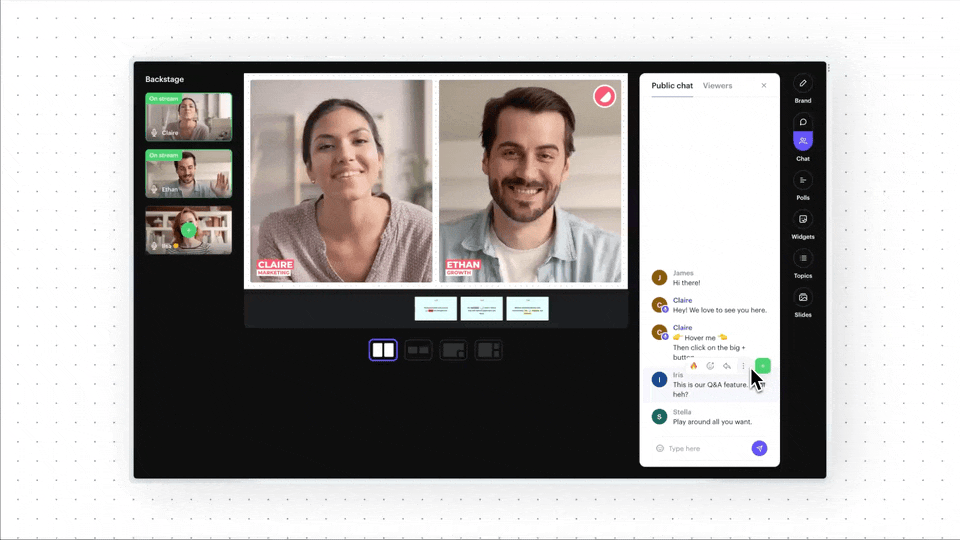
Finding Your Ideal Webinar Approach
Selecting the right format for your webinar depends on aligning with your goals, understanding your audience’s preferences, and considering the type of content you’re sharing. Live webinars are best for real-time engagement and connection, while pre-recorded webinars provide flexibility and a lasting resource.
By understanding the strengths of each format, you can create a webinar strategy that maximizes the impact of your content and helps you connect with a wider audience. Whether you opt for one format or a mix of both, webinars remain a powerful way to share knowledge, build relationships, and drive growth.


Run Modern Webinars to Engage your Audience
Start for free with up to 30 registrants. No credit card needed.
Start for free